lec #12: Vergence Treatment Part 1
1/84
There's no tags or description
Looks like no tags are added yet.
Name | Mastery | Learn | Test | Matching | Spaced |
|---|
No study sessions yet.
85 Terms
Vergence therapy programing
what techniques should you start with ?
begin with a technique that is within the capabilities of the pt
Vergence therapy programing
what is step #2?
begin VT by stressing the direction of difficulty
Vergence therapy programing
for step 3 what is the targets to start vergence therapy with?
start with peripheral or larger targets with high stereo content and gradually proceed to more central or smaller targets
Vergence therapy programing
step 4
allow some blur initially if it helps the pt fuse or use targets with less accommodative detail
Vergence therapy programing
step 5
true or false
we always train both positive and negative fusional vergence, regardless of the initial diagnosis.
TRUE
Vergence therapy programing
step 6
which should you emphasize first?
a. facility
b. amplitude
emphasize amplitude then facility
increasing speed and decreasing latency
Vergence therapy programing
step 7
begin with ________ not _______.
a. quantity
b. quality
begin with quality not quantity
what are 5 important factors to emphasize during binocular therapy?
1. kinesthetic awareness
2. the ability to clear and regain binocular vision as quickly as possible as the vergence demand increases
3. maintaining clarity when fusing
4. pt manipulates the targets not the therapist
5. the changes that occur are internal and occurring with the patients own visual system
what is the correct general sequence for vergence therapy?
a. step fusional vergence, vergence facility, gross fusional vergence step, smooth fusional vergence
b. smooth fusional vergence, gross fusional vergence, step fusional vergence, vergence facility
c. gross vergence, smooth fusional vergence, step fusional vergence, vergence facility
d. vergence facility, step fusional vergence, smooth fusional vergence, gross vergence
c. gross vergence, smooth fusional vergence, step fusional vergence, vergence facility
name 3 gross vergence techniques
- pencil push ups
- brock string
- barrel card/ 3-dot card
what are the 3 goals of pencil push ups?
- kinesthetic awareness of convergence
- improve gross convergence
- normalize the near point of convergence
what is the required equipment for pencil push ups?
alphabet pencil or other target appropriate
how do you do pencil push ups with pt?
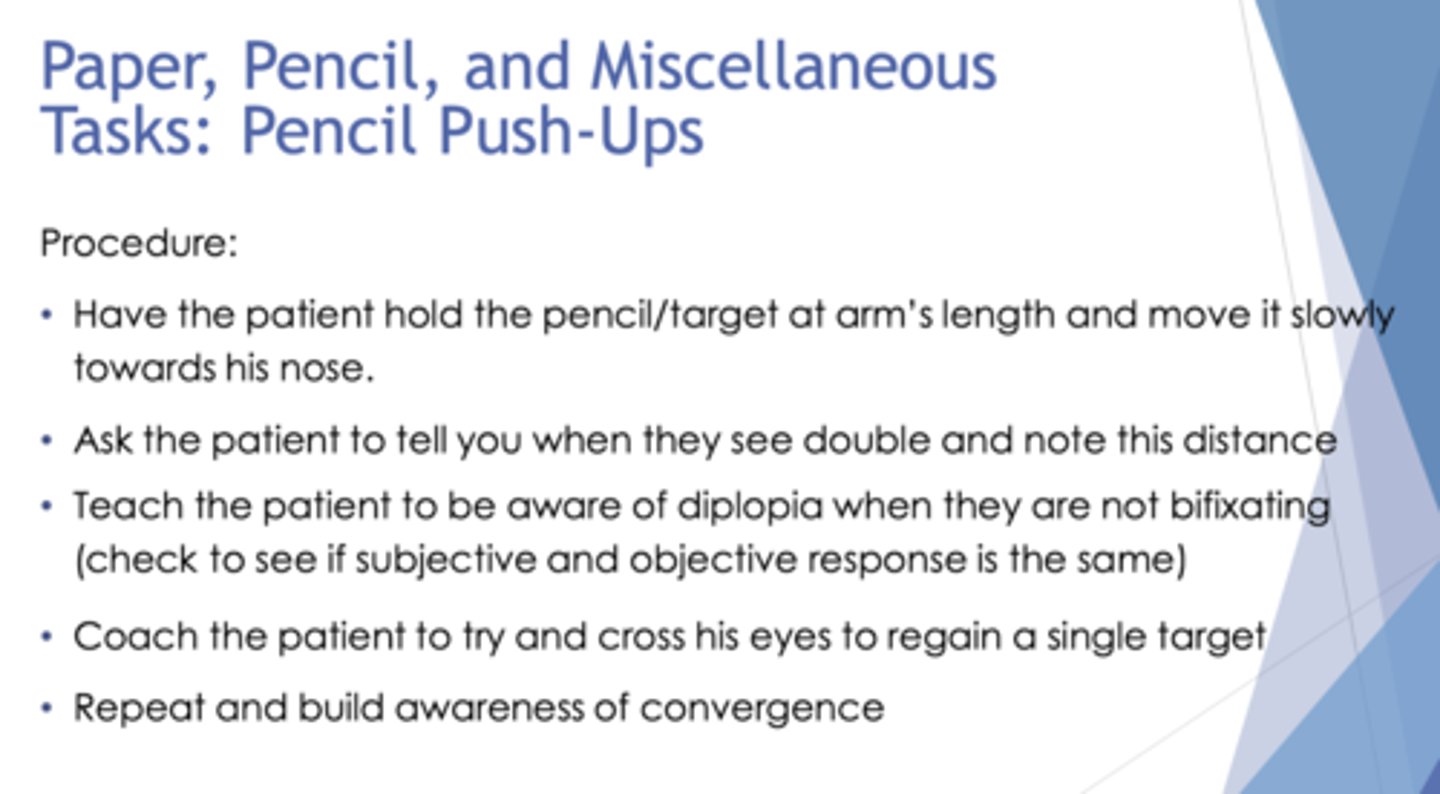
name two alternative procedures to pencil push ups?
pola mirror push ups
jump from far to near
when do you reach the endpoint of pencil push ups, how close from the face must pt converge and has to hold for how long?
- pt can convergence less than 6cm from nose for 30 seconds
what are the 3 requirements to reach endpoint of pencil push ups for vergence training?
- pt can convergence less than 6cm from nose for 30 seconds
- pt knows the feeling of eyes converging
- pt can maintain single vision while tromboning the target
pencil push ups is for training what type of vergence technique?
gross vergence
what type of activity is brock string?
gross vergence
what are the 3 goals of brock string?
- develop kinesthetic awareness of converging and diverging
- improve voluntary convergence
- normalize the near point of convergence
for level 1 of brock string how far is the bead initially from the pts eys?
12 inches away or outside the pts NPC
what is level 1 of brock string for vergence training?
pt holds string against nose, both eyes can see
place bead 12 inches away or outside the pts NPC
have pt look at center bead and describe what is seen
use feedback (like touch the bead) if need to help fuse
help the pt develop feeling of looking close and crossing his eyes
possible pt feedback from pt for brock string
how should the bead pt is looking at appear?
SINGLE and fused
how should the beads the pt is NOT focused on appear to the pt?
should appear double
physiological diplopia used as suppression check
what is normal physiological diplopia?
Physiologic diplopia, or “normal double vision”, is a phenomenon where objects are doubled, either in front of or behind, whatever target you focus on.
if your pt training on brock string cannot not see the two beads in front and behind the fixated bead as double what do you do?
pt is suppressing/ having trouble appreciating physiological diplopia
you can have them wear red green glasses
for brock string where the strings are crossing indicates what?
the accuracy of fixation
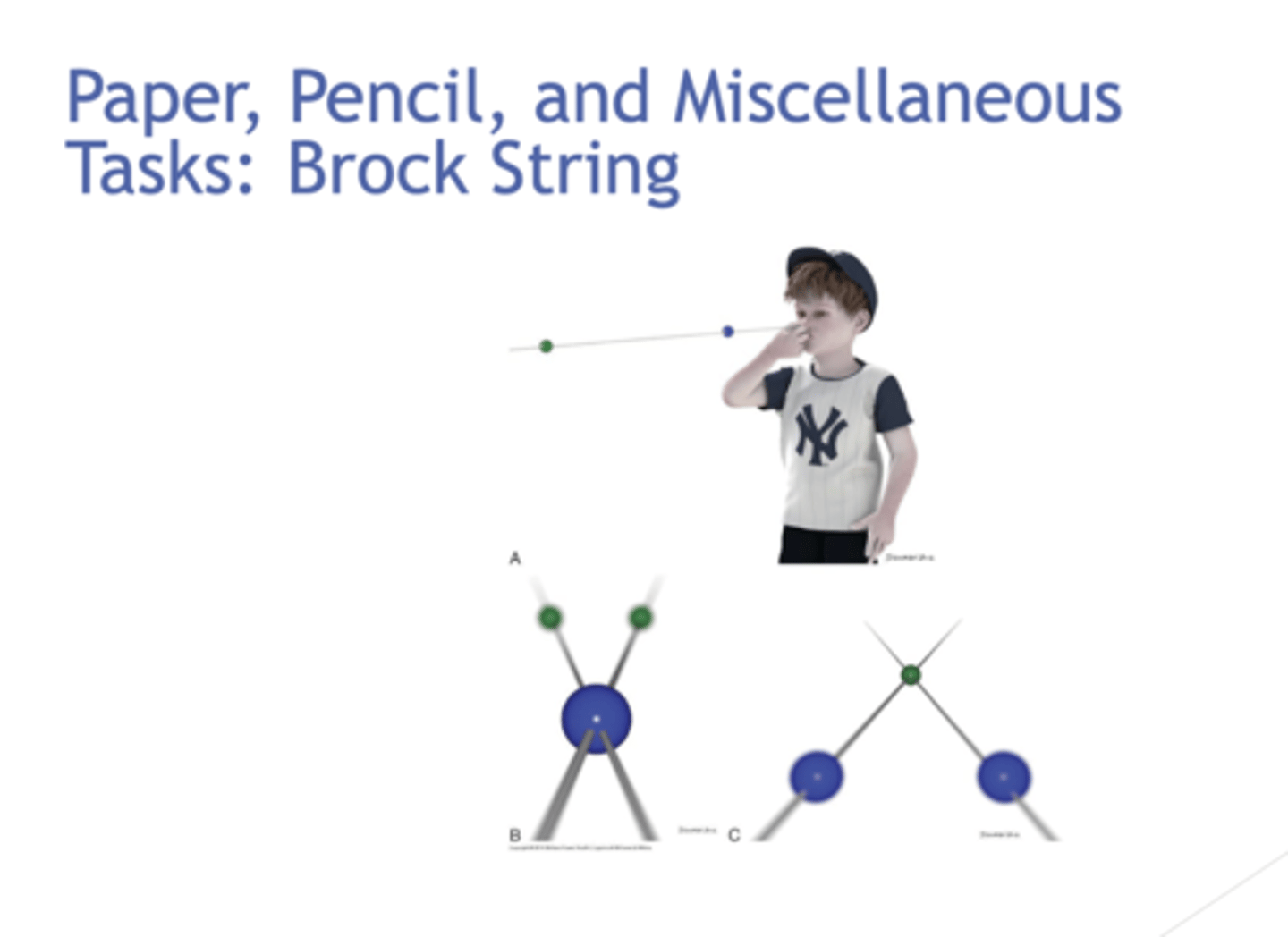
what is the next level of brock string once the pt is able to fuse the beads and understand feedback?
perform bead jumps
how do you set up brock string for bead jumps?
a. how far is the near bead?
b. how far apart are the other beads?
set the near bead outside the pts NPC
and the other beads about 12 inches apart
what is the time and reps for brock string bead jumps?
have the pt hold fixation at each bead for 10 seconds and repeat 10 times
what are 3 ways to adjust the difficulty of brock string level one?
- change the distance of the bead (closer = more convergence)
- perform bead jumps in different gazes (can add additional brock strings for saccadic integration)
- perform bead jumps in motion for pursuit integration
how can level one of brock string be used to train saccades and vergence
perform bead jumps in difference gazes with additional brock strings
how cna brock string level on be used to train pursuits and vergence?
perform bead jumps in motion
your pt is good with brock string bead jumps what is the next level up?
bug on a string
how do you do bug on a string for brock?
- remove all the beads
- have pt look at the far end of the string and make sure pt appreciates that there is an X where the pt is fixating
- very slowly fixate closer and closer moving the X down the string
- once the X reaches the nose have the pt walk the X back
which level of brock string requires no beads?
level 2 bug on a string
what is the end point for brock string level2? hint is the same as level 1 endpoint
- pt is able to converge <6cm from the nose and maintain for 30 seconds
- pt knows the feeling of convergence
- pt knows how to voluntary converge
how would you do brock string if the goal was to train divergence instead of convergence?
moving the string further away from the pt? is this right edgar
what are the 3 goals of doing the 3- dot or barrel card? hint same as brock string
training gross convergence
- develop kinesthetic awareness of convergence
- improve gross convergence
- normalize the near point of convergence
what is the only equipment needed to do 3-dot or barrel card?
card
what is level 1 of 3 dot or barrel card?
- have pt hold card at bridge of nose
- fixate the dot farthest away from him
- ask them what they see
- should see a mix of one dot and then the other dots as double (physiological diplopia)
- if pt is able to fuse the farthest dot have them switch to the center dot and hold for 10 seconds and then repeat with the near dot
- continue alternating fixation from one dot to the other
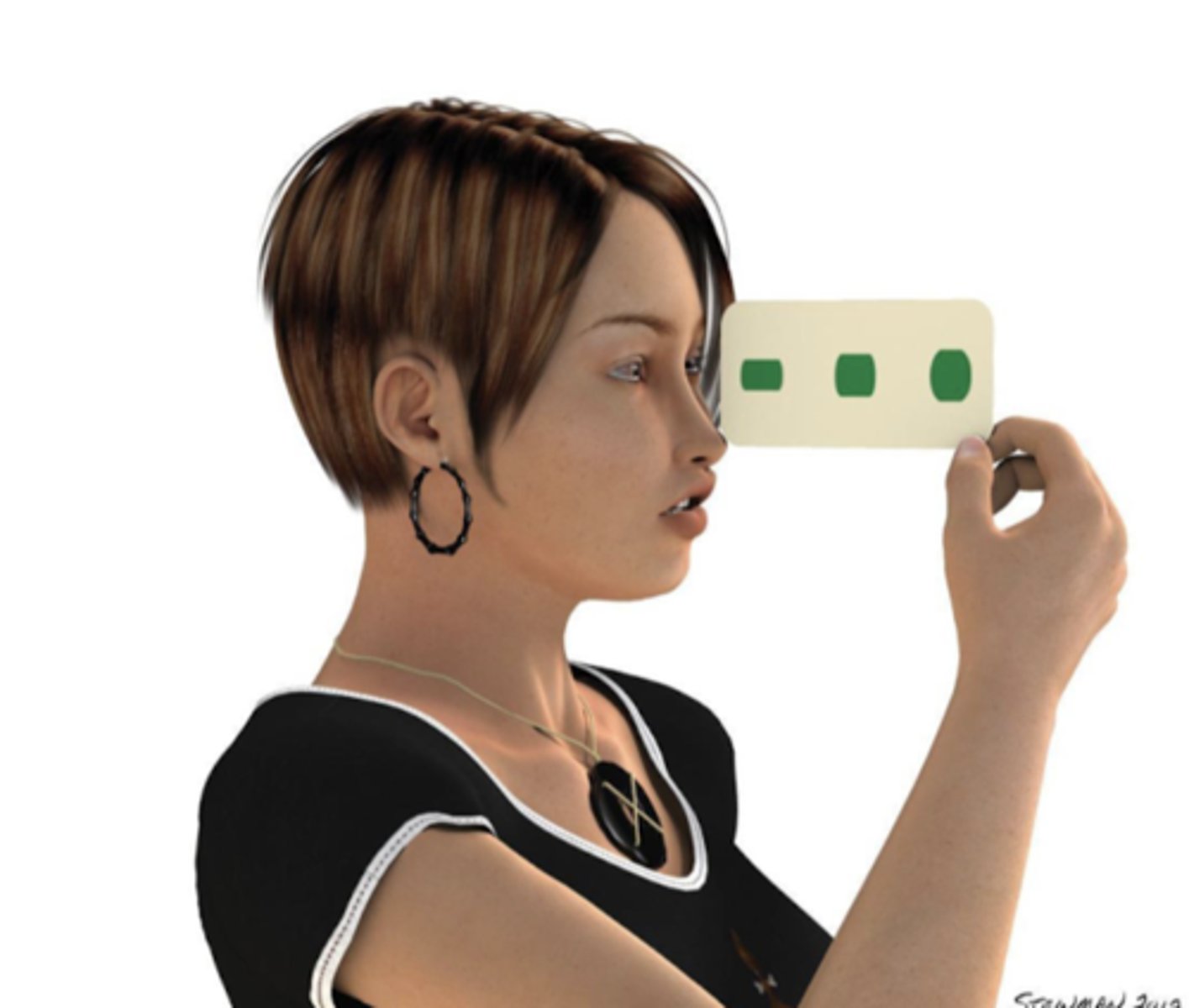
how can you make 3 dot card harder?
level 2 is alternate fixation between the dots and a distance target holding each for 10 seconds
what are two ways to make barrel card easier if pt is having trouble with level 2?
- have the pt touch the fixated dot
- move the card further away
what is the endpoint of 3 dot card or barrel card?
- the pt is able to fuse the smallest dot and maintain for 10 seconds
- pt can jump between the dots and distance target level 2
- pt knows the feeling of convergence
what are fusional vergence techniques?
smooth/ step vergence
what are 4 smooth/ step vergence fusional techniques?
1. variable tranaglyphs (red and green transparent screens use red green glasses)
2. variable vectograms (blue transparent screens with polarized glasses)
3. wheatstone
4. computerized binocular vision therapy programs
what fusional vergence techniques are only step vergence? (5)
- nonvariable tranaglyps
- eccentric circles/ free space fusion cards A
- lifesaver card/ free space fusion cards B
- aperture rule
- brewster stereoscope
what is the difference between variable and nonvariable tranaglyphs?
The variable tranaglyphs can be set at ortho or zero initially, before the demand is increased.
The nonvariable tranaglyphs are therefore considered a more difficult technique as these are fixed
what is the goal of using variable tranaglyphs and vectograms?
1. increase negative and positive fusional vergence amplitude and facility
2. decrease latency of fusional vergence response
3. increase the speed of the fusional response
amplitude and facility, latency, speed
equipment for variable tranaglyphs and vectograms
which uses red-green glasses?
which uses polarized glasses?
need a holder for the sheets
- red green glasses for tranaglyph
- polarized glasses for vectogram
all tranaglyphs and vectograms come in pairs that look indentical expect they have different ____________.
disparities
tranaglyph what eye sees what color?
red lens over the right eye so sees green
green lens over the left eye so sees red
when you separate the two screens horizontally what does this create?
they create vergence demand depending on how slides are shifted
crossed for base out
uncrossed for base in demand
scale at the bottom or top indicate prismatic demand if target viewed at 40cm
what is a prism diopter defined as?
a prism diopter demand is defined as a separation of 1cm at a distance of 1 meter
thus at 40cm a 4mm target depression is equal to 1pd
but if at a different distance this needs to be recal
what is the formula for calculating the target demand?
target separation in cm / training distance in meters
example what is target demand if targets are separated by 8cm and the training distance is 40cm?
convert 40cm to meters by dividing by 100
8cm/ .4m= 20pd
what is the target demand if pt is closer to target? at 20cm
8cm/.2m= 40pd
increase demand
decreasing the training distance _______ the difficulty of tranaglyphs/ vectogram.
increases
for tranaglyphs what is the correct sequence easier to harder targets?
a. central fusion cards then peripheral fusion cards
b. peripheral fusion cards then central fusion cards
b. peripheral fusion cards then central fusion cards
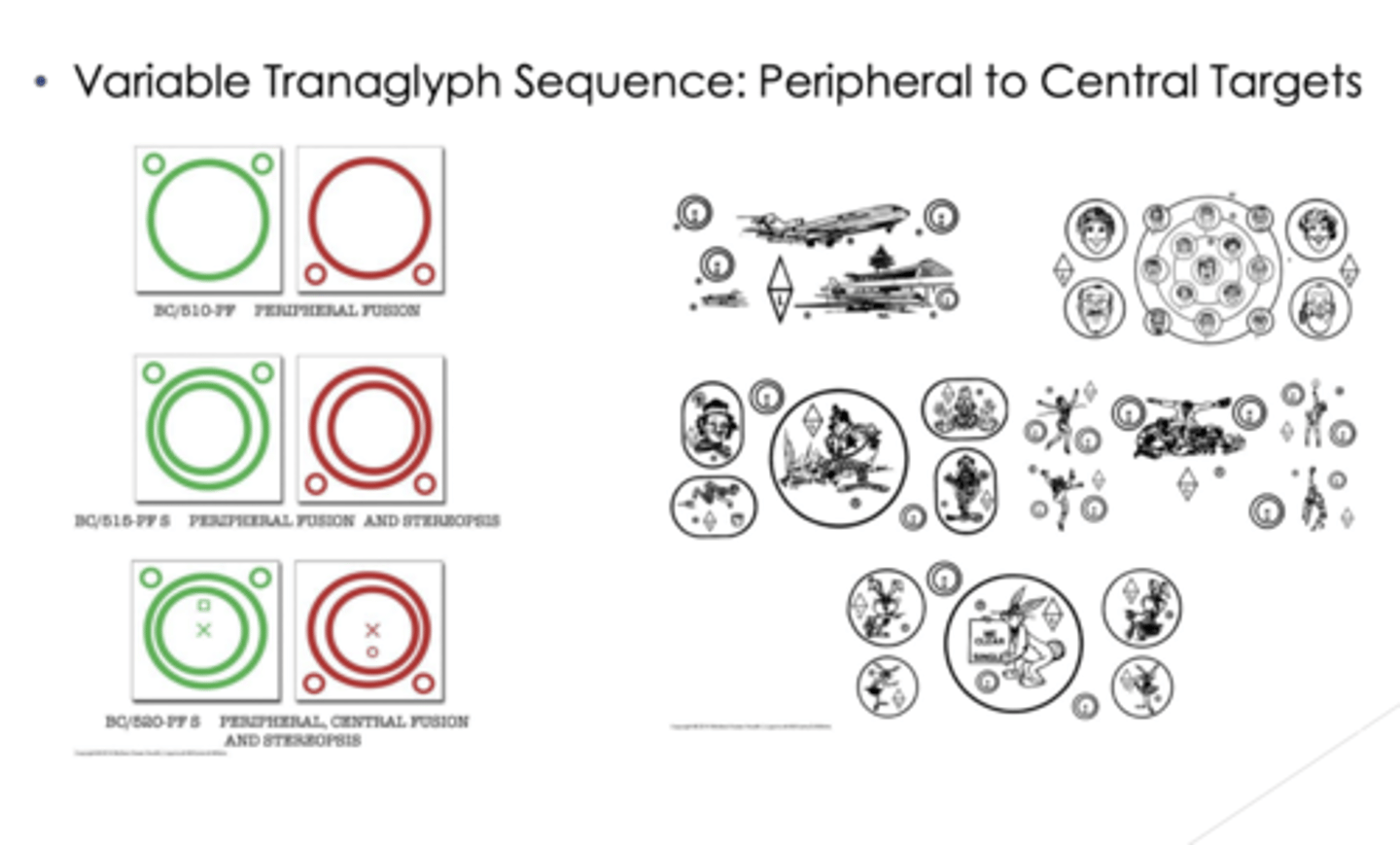
put the variable vectograms in the correct sequence from easier to harder
a.chicago skyline
b. clown
c. quoits
d. mother goose
e. spriangle
quoits
clown
mother goose
spiranlge
chicago skyline

what is level 1 of variable tranglyphs and vectograms?
what do you confirm the presence of?
how many pd do u move at a time?
train smooth fusional vergence
confirm pt sees SILO
move in increments of 3pd
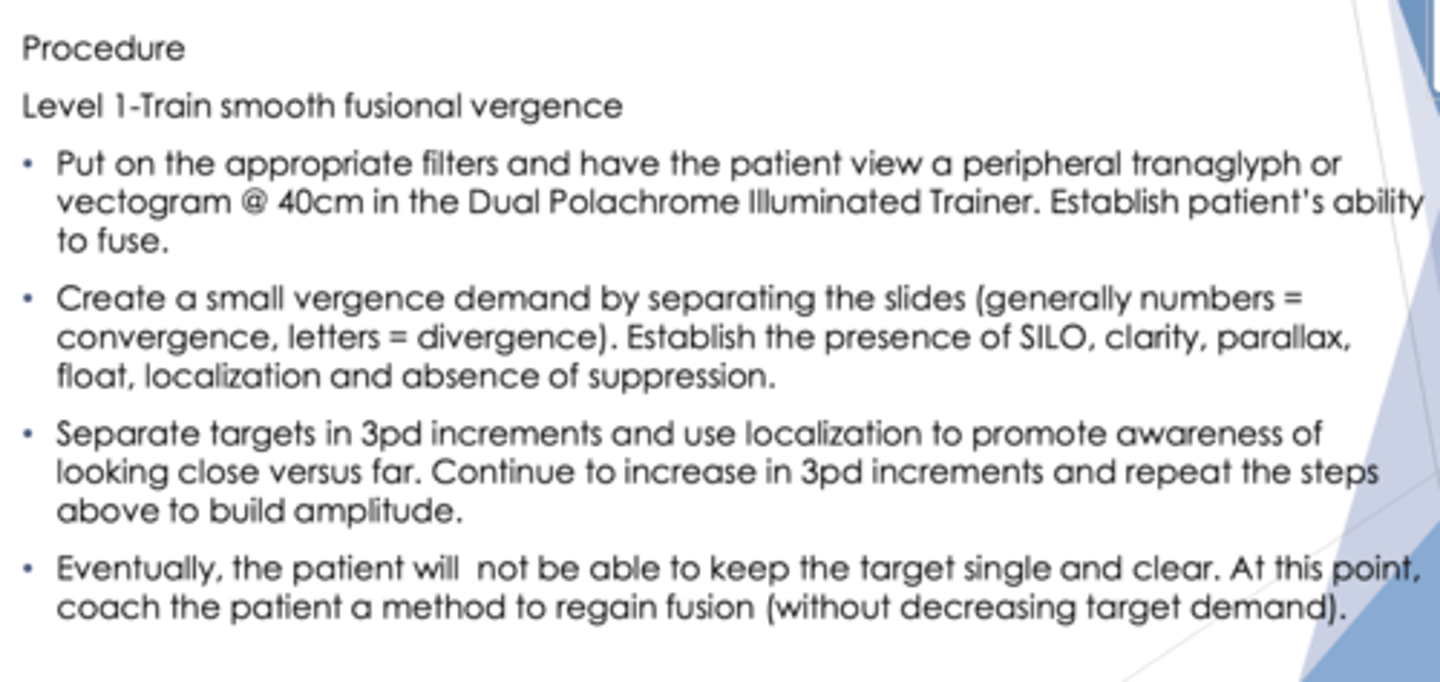
what does SILO mean?
convergence (SmallIn) and divergence (Large-Out).
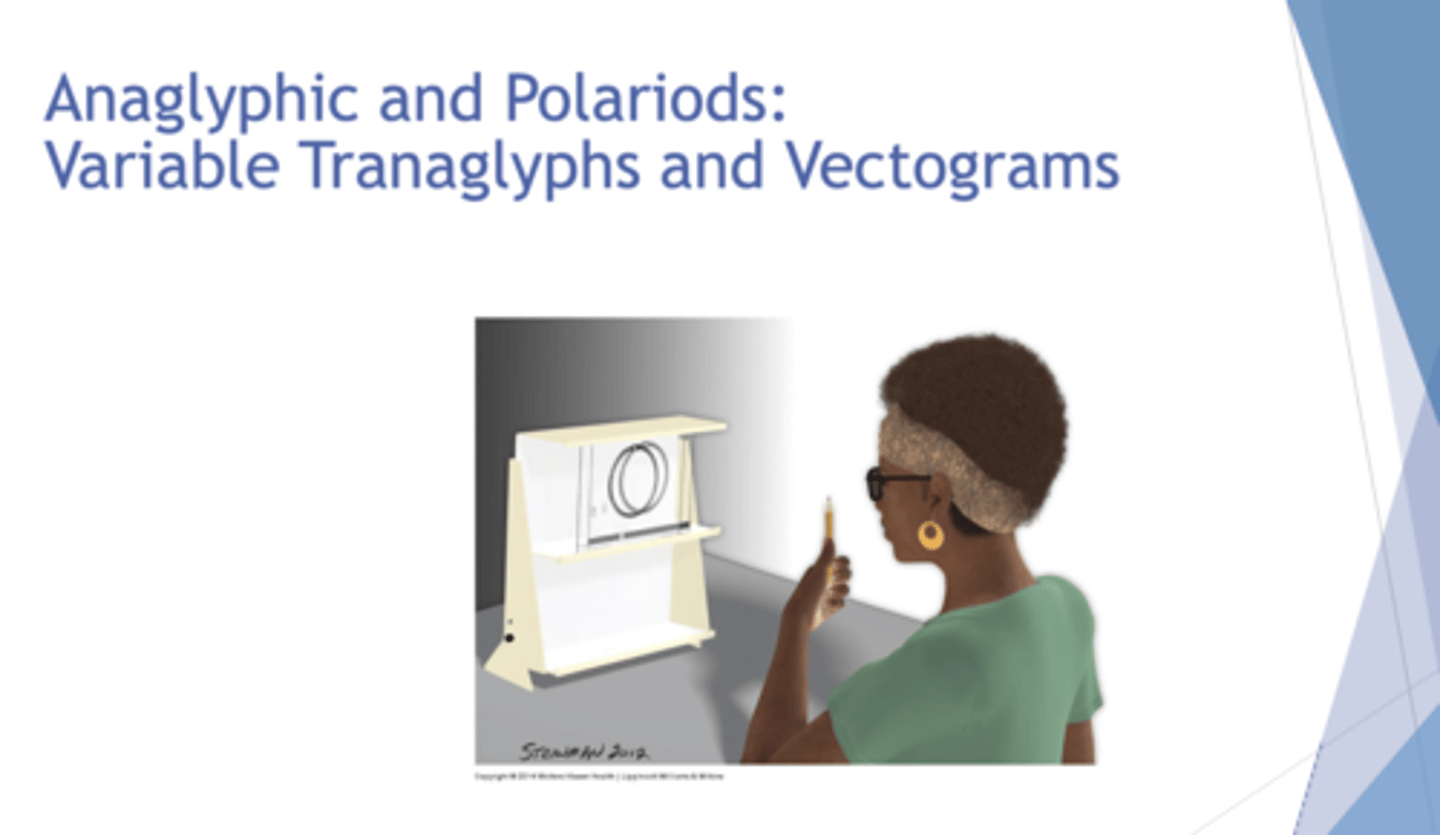
for convergence what should pt notice while moving targets with base out?
they would see the target getting smaller and closer to them
for divergence what should pt notice while moving targets with base in?
should see the target getting larger and further away
what is level 2 of variable tranaglyphs and vectograms?
train step fusional vergence
when can you move on to level 2?
when pt achieves moderate smooth fusional vergence abilities of 25 to 30pd base out and 20-25pd base in, then we do step demand to improve the facility
what are the steps to level 2 of variable tranaglyphs and vectograms?
how to you load 5 different ways
- look aways change fixation from th target to another point in space
- cover, uncover, and regain fusion
-BIM/BOP
- polaroid or anaglyphic flip lenses to alternate between divergence and convergence demand
- change fixation from distance and move to distance of most difficulty
you are training convergence on variable vectogram and want to load by adding lenses which will make it harder for ur pt?
BIMBOP
adding plus lenses will make it harder b/c now pt will have to convergence more and minus lenses would make it easier
what is the endpoint for variable tranaglyphs and vectograms?
pt can fuse 25-30 base out and 20-25 base in demands
pt can alternate from 20-25 base out to 15-20 base in
Wheatstone is aka
flying W
what does the wheatstone do?
instrument dissociates the two eyes using 2 mirrors
what are the 3 goals of of training with the wheat stone? hint same as variable T and Vec
1. increase positive and negative fusional amplitude facility
2. decrease the latency of the fusion vergence response
3. increase the speed of the fusional vergence response
helps with amplitude, latency, and speed
what is the equipment required to practice wheatstone?
- wheatstone mirrored stereoscope
- stereoscopic cards
- flip lenses
- flip prismes
what does level 1 of wheatstone train?
train smooth fusional vergence
what are the steps to performing level 1 wheat stone?
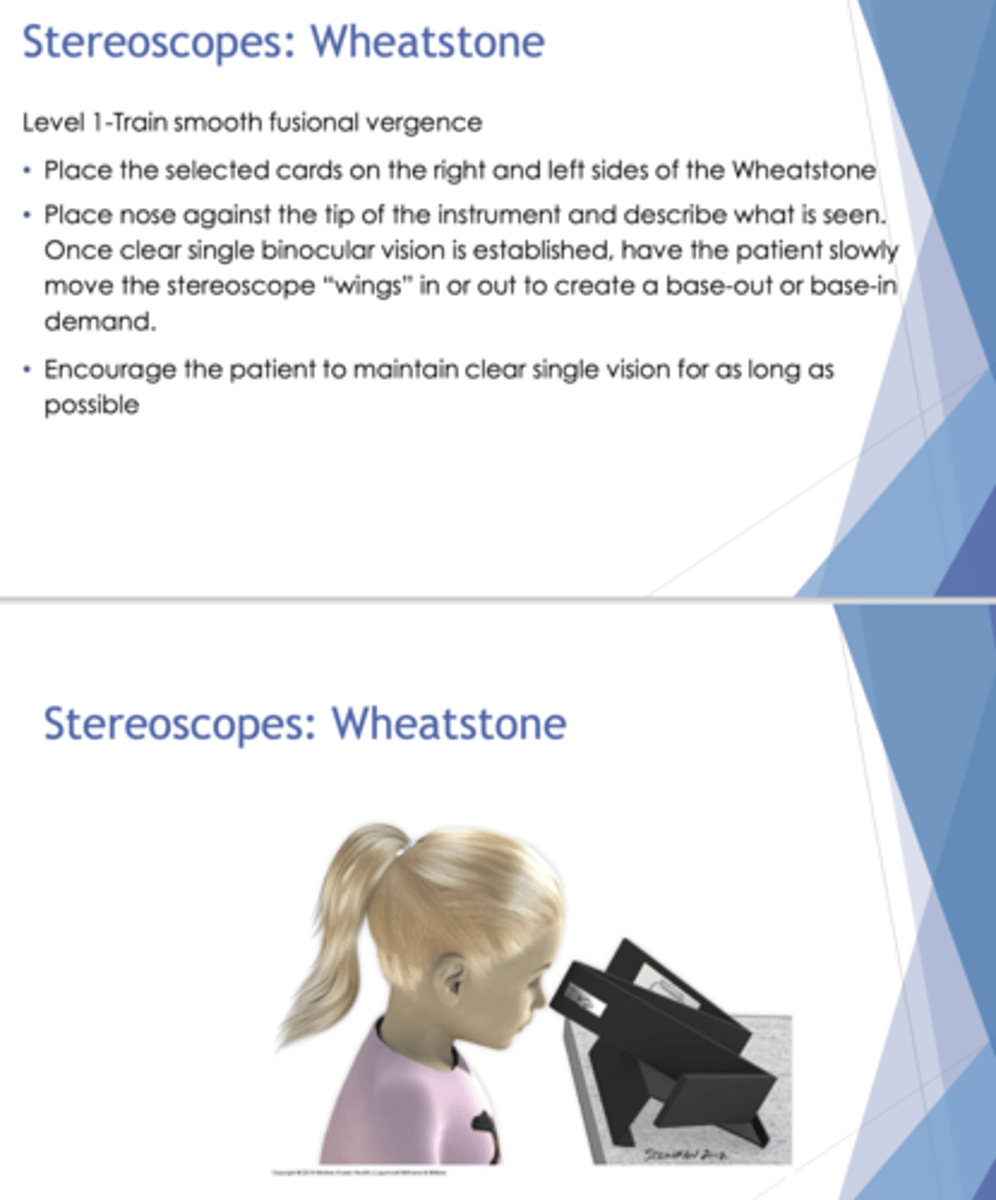
what does level 2 of the wheatstone train?
smooth or step?
step vergence
what do you perform level 2 flying W?
have the pt separate the targets several cms at a time fuse look away and then look back to regain clear single vision
repeated many times at increasing levels of distance/ difficulty
what is the endpoint for flying W?
how many pd base out?
how many pd base in?
pt is able to have single binocular vision with the selected cards up to 30pd for base out and 20pd for the base in
Computer orthoptics software programs (VTS3/4, HTS) is to train what? same as the other two vergence trainings
vergence
- helps increase amplitude and facility
- decreases the latency
- increase speed
what is equipment needed for computer ortoptics?
- computer program
- liquid Crystal or red/blue glasses

what is endpoint for the VTS3/4, HTS?
the pt is able to achieve single binocular vision with 40 to 50pds base out and 10 to 15pd base in
What is the goal of training with nonvariable tranaglyphs?
Increase facility, decrease latency, and increase speed
How are nonvariable tranaglyphs used?
Red green glasses
Look at target
Coach convergence and divergence to see 1 clear image
Switch from convergence to divergence is done by switching card around
Hold fusion of target for 10 seconds and then have pt point to floating target
Have pt look away for a few seconds and then look back, trying to regain as quickly as possible. Hold for 10 seconds.
If vectogram has fixed separation this is for training
a. Step vergence
b. Smooth vergence
Step vergence
What are two ways to increase the difficulty of nonvariable tranaglyphs?
Have the pt switch fixation from one target to the next within the same slide or a slide with greater separation
Add lesnes or prisms BIMBOP applies
What is the endpoint for nonvariable tranaglyphs?
pt can have single binocular vision with all 6 slides for convergence 30pd and up to card 4 for divergence of 20pd